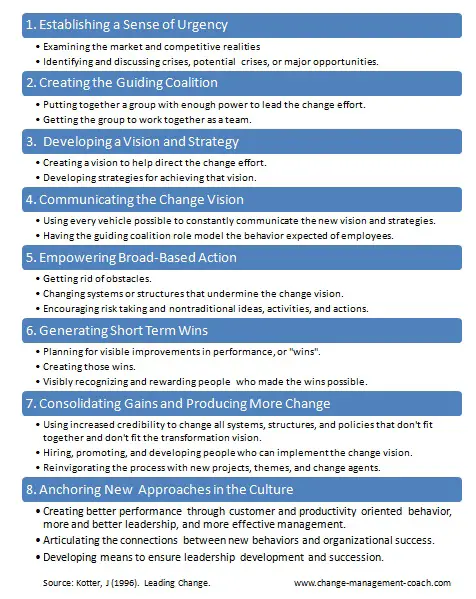- Home
- Theory & Models
Change Management Models
Change management models are useful in that they describe and simplify a process so that we can understand and apply the principles.
The top models of change management described on this page have proven their value but all focus on very different processes and outcomes.
Someone wise once said that all models are wrong but some models are useful.
At the end of the day the reality is that change models are created by people based on their research and experience. None of them describe a perfect change process.
Click to view the top models of change on this page.
Review: 8 Reasons You Should Use A Change Management Model
Think about it. If change always followed an exact pattern, if it was
always predictable, there wouldn't be a need for different models.
No matter how well you plan for change you should always expect a surprise. Change rarely follows the exact steps change management models suggest.
However, it's always good to work to a plan, especially using a model that's based on experience and observation.
So, explore these models of
change management and take what is valuable to you.
Allow yourself some flexibility when following a model rather than
following it too rigidly.
At a personal and organizational level the models of change we
choose are motivated by the way we approach change. There is no right or
wrong.
The way you go about implementing change will differ depending on the model you use, but there are basic steps that are essential to follow that are common to personal or organisational change.

Top Change Management Models
Kurt Lewin
Kurt Lewin's Unfreeze-Change-Refreeze model is popular as it's easy to understand and focuses on process. It's also inspired many similar
3-step change models that are really a spin on the Lewin
model.
Lewin's Force Field Analysis integrates with the three stage theory of
change. The Force Field Analysis is a great tool to motivate people
towards change and understand resistance.
ADKAR®
The ADKAR® model is frequently used in organisations. A practical model of change that is simple to learn, makes sense, and focuses on
the actions and outcomes required for change.
Kotter's 8-Step Model of Change

John Kotter's influential 8-step process for change
Discover the original 8-step change model...
PLUS significant updates introduced in Kotter's 2014 book Accelerate...
PLUS the up-to-date evolution and integration of theory into practical and relevant applications for meaningful change from Change (2021).
Stephen Covey: 7 Habits Model
Stephen Covey's
Seven Habits model is an inspiring sequential change management process
that challenges us to examine our values and the way we react to change
in our lives.
Apply the lessons originally published in The Seven Habits of Highly Effective People and learn to manage change effectively.
In 1998 Sean Covey published
The 7 Habits of Highly Effective Teens
effectively making the seven habits model more accessible and proving
that a solid model for managing change in life can be presented in a fun
and highly readable format.
Kubler-Ross: Stages of Change
The Kubler-Ross model describes typical responses to grief. These have been applied to understand change on an individual level and in the workplace.
 The Kübler-Ross Change Curve is Trade Marked (TM) by the Elisabeth Kübler Ross Family Limited Partnership.
The Kübler-Ross Change Curve is Trade Marked (TM) by the Elisabeth Kübler Ross Family Limited Partnership.When I use this model I find people are relieved to identify their feelings regarding change. But they most enjoy being able to identify and understand how other people respond to change. They immediately get a better sense of their own behaviour and why colleagues behave in a particular way.

Keep in touch by visiting our Facebook Page and clicking 'Like' to join the community.





